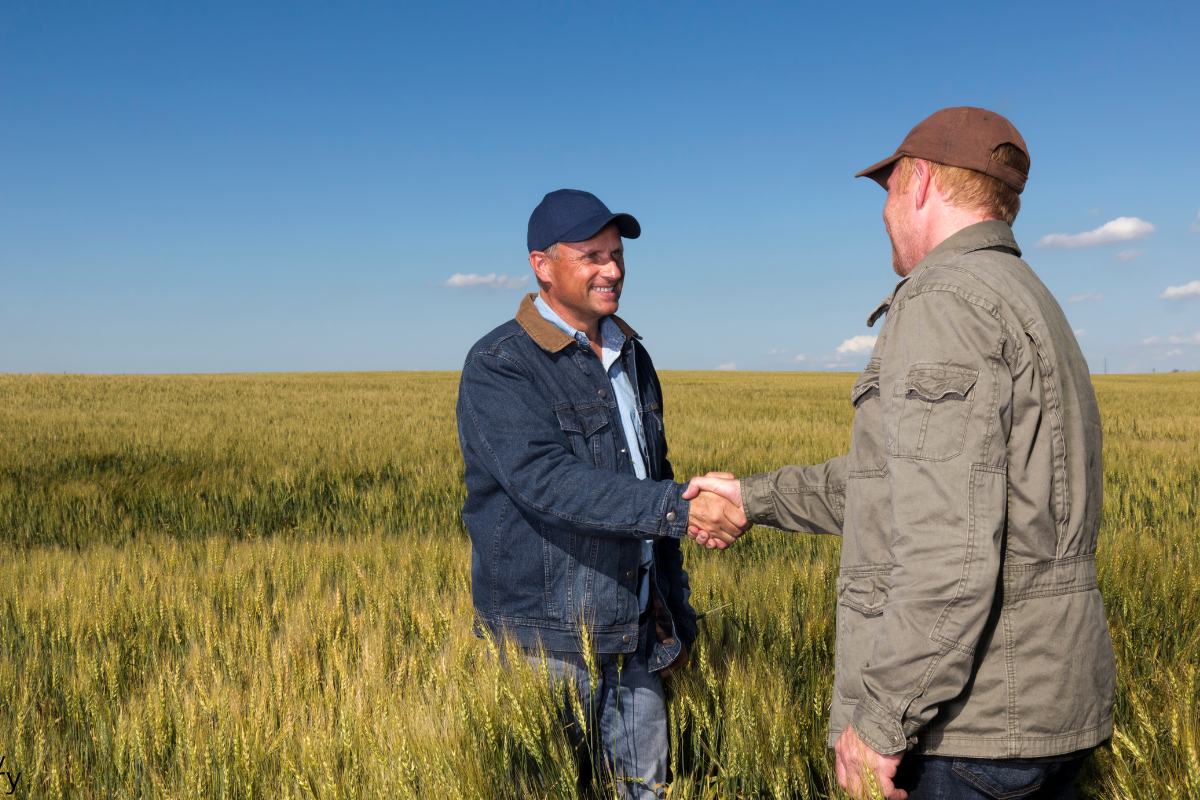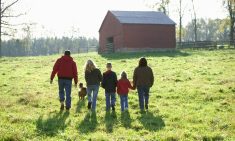Forced to pivot as they were starting up their farm, the Friesens did what most farmers excel at: finding solutions, workarounds and innovative approaches. Read on to find out what the rest of us can learn from their story.
– April Stewart, CG Associate Editor
It was the summer of 2015 and Christi and Kelly Friesen and their two young children found themselves living in a fifth-wheel trailer parked in a field near Brownvale in the Peace district, six hours northwest of Edmonton.
Read Also

Are you ready for farm succession?
What motivates some farmers to make a succession plan while others don’t seem worried.
To say it was an unexpected development is an understatement.
Earlier that year, in the spring, the Friesens had been sure what their plan was, and despite some clear stresses and strains (what farm doesn’t have its share of those?) they were on their way to a lifetime of family farming. Already, they had crops planted on 1,400 acres of leased land and had put down payments on a tractor and combine.
That, plus the plan, was effectively their total investment. “We didn’t own any land,” Christi says. “We didn’t even have a home quarter of our own.”
Soon they wouldn’t have a plan either.
Yet this is the story of how, today, Christi and Kelly are running their own 5,000-acre grain operation, aptly named Rebellion Farms. And of how, with help from their elementary school- aged children Kohlton and Kenzie plus a year-round full-time employee and one or two seasonals, they are making a success of it.
In 2021, after all, Rebellion Farms won the Peace’s family farm award for their contributions to the community and for their farm family values, and in January 2023, Christi became a member of the Alberta Canola Producers Commission’s board of directors.
So let’s get on with the story, and what the rest of us can learn from it.
The long road to success
Kelly had been raised on a family grain farm in the Peace, where, like many other aspiring farmers, he had begun an off-farm career, in his case as a journeyman power linesman. But the plan was to join the family farm.
Christi also grew up in the Peace country, raised in town but loving time outside, especially hunting.
After they married, the couple worked alongside Kelly’s parents. Their direction seemed set. Kelly left his linesman job, knowing one day he and Christi would take over the farm and they would raise their two small children as part of a multi-generation family business.
But the working relationship with his parents didn’t work. Personalities clashed. There were arguments about how things should be done. Things finally came to a head, and it was the worst-case farm succession scenario.
“It ended with us leaving,” Christi says, which is how she and Kelly came to spend those six months living in the fifth-wheel trailer with a toddler and a kindergartener.

First steps
It happened — they still remember the date — June 6, 2015, the day when so many of their certainties evaporated.
Yes, they had each other and they had a crop in the ground — on rented land — but, Christi says, “we didn’t have a sprayer.” And even if they could find a way to control the weeds and insects through the growing season, how could they get the harvest in without a truck or a bin?
It seemed there was no choice. They’d have to call the landlord, cancel their lease, give up their dream of farming.
The turning point
They struggled. But then another memorable day came. Christi recalls how she and Kelly were sitting in their fifth-wheel. They looked each other in the eye. It was the moment they now think of as their massive “TSN Turning Point.”
“Why can’t we do this on our own?” they each asked.
It became their defining moment. After that, they never looked back, although Christi naturally says, “it wasn’t without struggles.”
Their first trial was getting the crop sprayed. Kelly’s grandfather stepped in. He didn’t provide financial support but he gave them all the help he could. “He loaned us an old-school, pull-type sprayer,” Christi says. It got the job done.
“Things started to work out for us, after that.”
After a summer in the fifth-wheel, it was time for harvest. The Friesens had a combine, but no trucks, which meant another challenge to solve, but again, family members and friends helped.
Kelly’s grandfather even brought his John Deere 7720 combine out of retirement. “He couldn’t comprehend the modern yields,” Christi says, laughing. “His combine was full before he got to the end of the field.”
Fortunately too, that first year on their own proved a dry year. Harvest finished early and they had time to find a place to live.
Luck was on their side. A nearby quarter section of land with a house and shop came up for sale. It wasn’t ideal — “It was actually suited up for cattle, not necessarily grain,” Christi remembers — but it became theirs. They moved out of the fifth-wheel and into their “new” yard by October, before it got too cold for camping.
Christi’s family was very supportive. “My parents were pivotal,” she says. “Mom would come out and she would run the disk. Or dad would come harrow for us.” Sometimes Christi’s mother made meals during busy season. “We even had Mom in the combine.”
Kelly was able to work off-farm for extra cash, becoming a seasonal employee for the next three years.
The Friesens also began developing a business diversification plan. They bought an excavator and a bulldozer to generate off-farm income. This allowed them to hire an employee who could operate these machines but also be available to work on the farm during seeding and harvest.
Both moves were to prove instrumental. “In order to grow your farm you still need a little bit of off-farm income until you get where you want to be,” Christi says.
But they still had a farm to start from scratch. Even the simplest things were hard. Most farmers inherit a workshop filled with a random selection of the hammers, wrenches and stray bolts their parents or grandparents left behind. The Friesens traveled to farm auction sales to bid on crates of small tools and odds and ends to build up a supply of the things you don’t know you need until you need them immediately.
As well, many farmers rely on the older generation for help and advice with farm production or management issues. After the summer of 2015, the Friesens didn’t have that option. “We think about that all the time,” Christi says.
Even so, they began to see the start of Rebellion Farm as a chance to implement their own ideas. Christi took formal training, earning her agronomy certification from Olds College and the couple put a priority on soil health and new technology.
“There’s an old-school way of farming up in the Peace, and there’s a new-school way,” says Christi. The Friesens found that with less cultivating and harrowing, they increased the organic matter in their soils. “Some of our fields have actually changed in consistency.”

Good advice
For some financial advice, the Friesens look to their lender. The couple works with Agriculture Financial Services Corporation (AFSC), a crown corporation of the Alberta government. They have been able to tap into AFSC’s incentives for young farmers, programs like the Next Generation Loan Program. “That was our saving grace,” Christi says. “Because we were so young and we had good credit.”
Strong relationships help too. The Friesens have found their local product lending specialist, Denise Ruecker, at AFSC to be very helpful. “She’s local, she gets it,” Christi says. “She understands our farm and knows what we’re trying to do. She’s been crucial.”
It also helps that Kelly is what Christi calls a “numbers guy” who tracks farm revenues and projections and manages farm risk with tools including Cargill’s MarketSense program. “That has been pivotal in how we run our business,” Christi says.
But it also takes the human side. The first season Christi and Kelly were on their own, they had 300 acres seeded to canola. They had a combine, but no swather at a time when straight cutting really wasn’t an option.
“We reached out to a few people that we thought would help us,” Christi says, but they came up short. As the days passed, the canola ripened. Soon the Friesens were getting desperate, searching for a custom swather and wondering how they’d manage to pay for it. Then a farm family, Bob and Kim Alexander and their son Travis, stepped up to help. “I remember it like it was yesterday,” Christi says. “They didn’t even charge us. They did it in 24 hours.”
The Alexanders and the Friesens still have a close relationship and take time to help each other out. Christi gets emotional when she remembers the kindness the Alexanders showed them at a time when, she says, “things were really, really dire for us.” When times are tough, she says, “there are people who will be in your corner.”
Looking back, and forward
A decade after their rocky start, Christi says modestly, “I think we’re doing okay.” The Friesens farm is thriving by anyone’s standards They started out without one grain bin. Their current project is a full pneumatic air system to streamline grain handling in their bin yard. During the 2023 harvest they ran two combines, with a third older machine on standby in the shop.
Now, Christi and Kelly also see Kelly’s parents a couple of times of year and are rebuilding bridges, and their kids see their grandparents often and have a good connection.
Yes, building the farm has been a struggle at times, and yes, it would have been easier to simply inherit it. But there have been compensations too. “It was an awful experience to go through,” Christi says, “but at the same time, I thank God every day.”
To start a new farm

Clint Fischer is an agribusiness advisor and the creator of the online ag community, Braintrust Ag, which provides resources and networking for farmers. Fischer is based in South Dakota, but, as he says, “business knows no borders.”
Fischer has dealt with families like the Friesens, and he’s not surprised they’ve managed to make it. “I talk to first-generation farmers frequently, so I know it’s possible,” Friesen says.
But, he adds, new farmers have to find new and different ways to build their businesses. “You have to get out of your own way and think creatively,” he says.
Fischer’s advice for others on that path:
1. Use your time wisely
Spend limited time and energy on tasks that will have the highest impact and the highest return on investment. For example, a new farmer might hire a custom harvester to take off the crop and spend their own time learning how to market that crop for a premium price. “Spend your time learning how to earn every penny you can,” Fischer advises.
2. Build strong relationships
Fischer tells aspiring farmers that relationships are key. Focus on building your links to local people within the ag community, he says,” because these lead to opportunities.” Such relationships can help new farmers find land to rent or ways to swap labour or other assets in exchange for borrowing equipment. Says Fischer: “These types of scenarios are highly valuable when starting from scratch.”
3. Develop an “Ag-Adjacent side hustle”
Fischer says the most important question for first generation farmers is: “How can we get our foot in the door?”
An “ag-adjacent side hustle” is one way to do that while still working a full-time non-farm job. Fischer defines the side- hustle as a business complementary to other people’s ag operations. For example, he says, look into pressure washing equipment after seeding and harvest, or custom spraying. Or it could be custom harvesting, fixing fences, removing old fences, setting up precision ag equipment, or filling out paperwork for government grants. Such ventures are low capital to start, but mean you’ll spend solid time with area farmers.
An ag-adjacent business gives a new farmer a reason to contact established farmers, and a way to spend time with them. While they’re talking, the new farmer can steer the discussion toward questions like, “Do you know of any land coming up for sale or rent?”
A good ag-adjacent side hustle should eventually allow a new farmer to scale back or leave their off-farm full-time job, keeping the side hustle as a diversified farm income stream, “which helps us weather the storms.” Or they could sell the side hustle and invest the capital into the farm.
4. Buy assets carefully
New farmers may be tempted to use earnings from their off-farm jobs to make machinery payments. Fischer doesn’t recommend it. “I don’t want to rely on my off-farm job to subsidize something that the farm is supposed to cover.”
Instead, he says, an older piece of equipment might be a better option. Equipment can also be leased, or the entire job could be hired out custom. “There are other ways to skin that cat.”
With today’s high machinery prices, Fischer says, “buying new doesn’t help you sleep at night.”
– This article was originally published in the October 2024 issue of Country Guide.
















